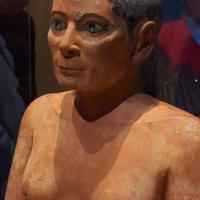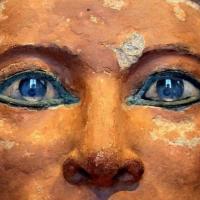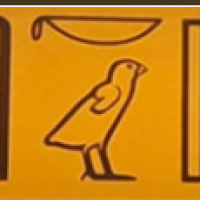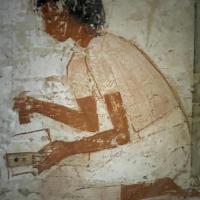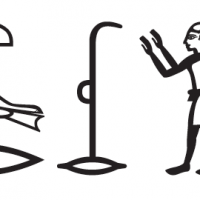Scribe, celui qui écrit ; les hiéroglyphes, "Medou Netjer" avaient une fonction magique. Les écrire ou les prononcer avait du sens ..
Le verbe sesh peut être traduit synthétiquement par "tracer". La forme nominale sesh désignait aussi le scribe, celui qui écrit. L’artiste dessinateur était alors dénommé sesh-kedout, que l’on traduit maintenant par "scribe des contours" ou "scribe des formes". Au temps des pharaons l’image entretenait un lien étroit avec l’écriture dans sa fonction et dans sa forme. Faut-il penser pour autant que tous les dessinateurs d’alors savaient écrire et que tous les scribes savaient dessiner ?Scribe, celui qui écrit ; les hiéroglyphes, "Medou Netjer" avaient une fonction magique. Les écrire ou les prononcer avait du sens ...
Le verbe sesh peut être traduit synthétiquement par "tracer". La forme nominale sesh désignait aussi le scribe, celui qui écrit. L’artiste dessinateur était alors dénommé sesh-kedout, que l’on traduit maintenant par "scribe des contours" ou "scribe des formes". Au temps des pharaons l’image entretenait un lien étroit avec l’écriture dans sa fonction et dans sa forme. Faut-il penser pour autant que tous les dessinateurs d’alors savaient écrire et que tous les scribes savaient dessiner ?Fabien Sennedjem Dessaux à Louvre Lens le 10122022
Le verbe sesh peut être traduit synthétiquement par "tracer". La forme nominale sesh désignait aussi le scribe, celui qui écrit. L’artiste dessinateur était alors dénommé sesh-kedout, que l’on traduit maintenant par "scribe des contours" ou "scribe des formes". Au temps des pharaons l’image entretenait un lien étroit avec l’écriture dans sa fonction et dans sa forme. Faut-il penser pour autant que tous les dessinateurs d’alors savaient écrire et que tous les scribes savaient dessiner ?Scribe, celui qui écrit ; les hiéroglyphes, "Medou Netjer" avaient une fonction magique. Les écrire ou les prononcer avait du sens ..
Le verbe sesh peut être traduit synthétiquement par "tracer". La forme nominale sesh désignait aussi le scribe, celui qui écrit. L’artiste dessinateur était alors dénommé sesh-kedout, que l’on traduit maintenant par "scribe des contours" ou "scribe des formes". Au temps des pharaons l’image entretenait un lien étroit avec l’écriture dans sa fonction et dans sa forme. Faut-il penser pour autant que tous les dessinateurs d’alors savaient écrire et que tous les scribes savaient dessiner ?Laurence Durand
Le verbe sesh peut être traduit synthétiquement par "tracer". La forme nominale sesh désignait aussi le scribe, celui qui écrit. L’artiste dessinateur était alors dénommé sesh-kedout, que l’on traduit maintenant par "scribe des contours" ou "scribe des formes". Au temps des pharaons l’image entretenait un lien étroit avec l’écriture dans sa fonction et dans sa forme. Faut-il penser pour autant que tous les dessinateurs d’alors savaient écrire et que tous les scribes savaient dessiner ?Scribe, celui qui écrit ; les hiéroglyphes, "Medou Netjer" avaient une fonction magique. Les écrire ou les prononcer avait du sens ..
Le verbe sesh peut être traduit synthétiquement par "tracer". La forme nominale sesh désignait aussi le scribe, celui qui écrit. L’artiste dessinateur était alors dénommé sesh-kedout, que l’on traduit maintenant par "scribe des contours" ou "scribe des formes". Au temps des pharaons l’image entretenait un lien étroit avec l’écriture dans sa fonction et dans sa forme. Faut-il penser pour autant que tous les dessinateurs d’alors savaient écrire et que tous les scribes savaient dessiner ?Scribe, celui qui écrit ; les hiéroglyphes, "Medou Netjer" avaient une fonction magique. Les écrire ou les prononcer avait du sens ..
Pinceau en fibre de palme. 1 390 à 1 352 B.C.E, Thèbes. 18e dynastie, Amenhotep III.Laurence Durand
Le verbe sesh peut être traduit synthétiquement par "tracer". La forme nominale sesh désignait aussi le scribe, celui qui écrit. L’artiste dessinateur était alors dénommé sesh-kedout, que l’on traduit maintenant par "scribe des contours" ou "scribe des formes". Au temps des pharaons l’image entretenait un lien étroit avec l’écriture dans sa fonction et dans sa forme. Faut-il penser pour autant que tous les dessinateurs d’alors savaient écrire et que tous les scribes savaient dessiner ?Scribe, celui qui écrit ; les hiéroglyphes, "Medou Netjer" avaient une fonction magique. Les écrire ou les prononcer avait du sens ..
Le verbe sesh peut être traduit synthétiquement par "tracer". La forme nominale sesh désignait aussi le scribe, celui qui écrit. L’artiste dessinateur était alors dénommé sesh-kedout, que l’on traduit maintenant par "scribe des contours" ou "scribe des formes". Au temps des pharaons l’image entretenait un lien étroit avec l’écriture dans sa fonction et dans sa forme. Faut-il penser pour autant que tous les dessinateurs d’alors savaient écrire et que tous les scribes savaient dessiner ?Scribe, celui qui écrit ; les hiéroglyphes, "Medou Netjer" avaient une fonction magique. Les écrire ou les prononcer avait du sens ..
Le verbe sesh peut être traduit synthétiquement par "tracer". La forme nominale sesh désignait aussi le scribe, celui qui écrit. L’artiste dessinateur était alors dénommé sesh-kedout, que l’on traduit maintenant par "scribe des contours" ou "scribe des formes". Au temps des pharaons l’image entretenait un lien étroit avec l’écriture dans sa fonction et dans sa forme. Faut-il penser pour autant que tous les dessinateurs d’alors savaient écrire et que tous les scribes savaient dessiner ?L’un des médecins les plus célèbres de l’Égypte ancienne.
"Ni–Ankh Ra" … Dans l’ancien Empire, il est le médecin en chef de la cour, qui est informé des secrets quotidiens du roi. Il est représenté assis au sol avec sa jambe gauche érigée et sa main droite attachée à son pied gauche dans une position inhabituelle, portant un petit kilt et une perruque. Cette statue est sculptée à partir de calcaire, sixième dynastie, l'ère de l'Ancien Royaume : « Les Médecins dans l’Égypte ancienne : Tamer Ahmed Abdel Fattah »L’un des médecins les plus célèbres de l’Égypte ancienne.
"Ni–Ankh Ra" … Dans l’ancien Empire, il est le médecin en chef de la cour, qui est informé des secrets quotidiens du roi. Il est représenté assis au sol avec sa jambe gauche érigée et sa main droite attachée à son pied gauche dans une position inhabituelle, portant un petit kilt et une perruque. Cette statue est sculptée à partir de calcaire, sixième dynastie, l'ère de l'Ancien Royaume : « Les Médecins dans l’Égypte ancienne : Tamer Ahmed Abdel Fattah »Fabien Sennedjem Dessaux à Louvre Lens le 10122022
Je connais les secrets des hiéroglyphes ...Qui était réellement BOUTEHAMON, scribe de l'Ancienne Égypte ?
Il s'agit d'un personnage très connu de la fin de la 20e et du début de la 21e dynastie, période charnière connue sous le nom d'"Ère de la renaissance". Son nom est inscrit à plusieurs reprises à Medinet Habu. Afin de renflouer les caisses de l'État, ce scribe de haut rang, qui était censé protéger les tombeaux de la Vallée des rois contre les pillards, aurait eu en vérité pour mission de voler des objets de valeur dans les hypogées d'anciens pharaons, dont celles des Ramsès !Qui était réellement BOUTEHAMON, scribe de l'Ancienne Égypte ?
Il s'agit d'un personnage très connu de la fin de la 20e et du début de la 21e dynastie, période charnière connue sous le nom d'"Ère de la renaissance". Son nom est inscrit à plusieurs reprises à Medinet Habu. Afin de renflouer les caisses de l'État, ce scribe de haut rang, qui était censé protéger les tombeaux de la Vallée des rois contre les pillards, aurait eu en vérité pour mission de voler des objets de valeur dans les hypogées d'anciens pharaons, dont celles des Ramsès !Qui était réellement BOUTEHAMON, scribe de l'Ancienne Égypte ?
Il s'agit d'un personnage très connu de la fin de la 20e et du début de la 21e dynastie, période charnière connue sous le nom d'"Ère de la renaissance". Son nom est inscrit à plusieurs reprises à Medinet Habu. Afin de renflouer les caisses de l'État, ce scribe de haut rang, qui était censé protéger les tombeaux de la Vallée des rois contre les pillards, aurait eu en vérité pour mission de voler des objets de valeur dans les hypogées d'anciens pharaons, dont celles des Ramsès !Mitri a vécu pendant la cinquième dynastie et a servi son pharaon.
Peut-être Unas, vers 2400 B.C.E. Il a construit une grande tombe à l'angle sud-est de l'enceinte de la pyramide échelonnée, près de la chaussée du roi Unas. Le sculpteur a entouré les yeux de cuivre et a utilisé de beaux cristaux de roche pour donner à Mitri un regard calme de gris profond. Les cristaux gris sont souvent bleus sur les photos. C'est un effet frappant §Tableau d'écriture d'un apprenti scribe.
Première période intermédiaire Dynastie 11 ou avant, environ 2 030 B.C.E. Il ressort clairement des hiéroglyphes maladroitement formés et de leur espacement inégal que c'est l'œuvre d'un apprenti scribe qui pratiquait son écriture. Le tableau d'écriture pourrait être utilisé encore et encore en grattant ou en essuyant l'encre et en ajoutant une nouvelle couche de blanc. Un autre tableau d'écriture de la collection montre les corrections faites à l'encre. Le Met New York.Marie-Thé Perardelle.
Vallée des Nobles, TT69, tohypogée de Menna, "Scribe des champs du Seigneur du Double-Pays" Les scribes contrôlent tout !Scribe, celui qui écrit ; les hiéroglyphes, "Medou Netjer" avaient une fonction magique. Les écrire ou les prononcer avait du sens ..
L’ensemble représente le hiéroglyphe du mot « scribe »Scribe, celui qui écrit ; les hiéroglyphes, "Medou Netjer" avaient une fonction magique. Les écrire ou les prononcer avait du sens ..
Hiéroglyphe du groupe Y symbolisant la palette du scribe (et par extension, celui-ci).https://www.letemps.ch/culture/premiere-phrase-entiere-decouverte-lun-plus-anciens-alphabets-connus-parle-poux
La première phrase entière découverte dans l’un des plus anciens alphabets connus parle de poux ! «Que cette défense éradique les poux des cheveux et de la barbe»: l’inscription en cananéen, qui figure sur un peigne découvert en Israël en 2016, remonte à plus de 3700 ansSechat en hiéroglyphe
Sechat ...


